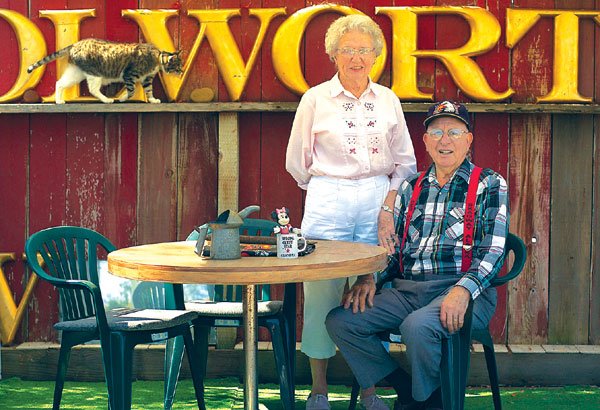Gilroy residents Al and Betty Gagliardi used to have a lush,
green lawn, but that was more than 20 years ago.
Gilroy residents Al and Betty Gagliardi used to have a lush, green lawn, but that was more than 20 years ago.
“When the drought hit (in the late 1970s), we were asked to only use what we needed – no water after 9am or before 5pm or 6pm,” said Al Gagliardi. “I was caught up with it because it is a natural resource, something important, so I started keeping a log.”
Each day, Al Gagliardi went faithfully to his water meter, cataloguing usage for the day. On the days he and his wife watered their lawn, they used about 400 gallons of water. On other days, especially those where they weren’t doing laundry, they used 30 or 40 gallons.
The figures were enough to convince Al Gagliardi to rip out his lawn and try something different. Instead of turf, his home sports kidney-shaped swirls of granite and volcanic rock, edged with large stones and accented with bonsai trees, homemade wooden art pieces and garden knick-knacks he’s scavenged for at garage sales.
Few things in the garden are consistent. Al Gagliardi likes change too much for that, said Betty Gagliardi.
“Over the years, he’s changed a little here and a little there,” she said. “Something gets too big and he takes it out, or he decides he wants to try something new.”
One thing that is seemingly everywhere in the garden is a saying, tooled into wood and sandblasted into slate and marble, that reads, “The kiss of the sun for pardon, the song of the birds for mirth, you’re nearer to God in a garden than anywhere else on Earth.”
It’s Betty Gagliardi’s favorite quote, so Al Gagliardi has carved it afresh on each new medium he’s dabbled with in the 38 years they’ve shared their home.
“He’s always been very handy,” said Betty Gagliardi, pointing to the assortment of bird houses and decorative figures her husband has made over the years. “He’ll just look at something and decide to make it.”
The garden’s largest spot of shade is a small, pergolad path leading from front yard to back, which is lined on either side with the bonsai plants Al Gagliardi has grown for years. Nestled among the tiny potted trees – everything from maples and junipers to miniature schefflera, oaks and pines kept in tiered pots – are bits of history that Al Gagliardi has brought home: old ceramic milk bottles, a chess set carved of solid rock and an old teapot with a bonsai sprouting from its spout.
“Betty hates it when I go to a garage sale because she never knows what I’ll bring home,” said Al Gagliardi with a light chuckle. “I’m not as bad anymore, though. Now I only get what I need or what I want.”
Al Gagliardi has spied some fairly unique finds at garage sales of the past. He’s picked up an old Woolworth’s Department Store sign, which now graces the back yard fence, a distinctive old Texaco gas pump and a minor army of vintage garden ornaments in the shape of deer, frogs and ducks.
“If there’s anything out there to collect, he’ll collect it,” said Betty Gagliardi.
But, unlike collectors of rare stamps or precious jewels, Al Gagliardi doesn’t worry about theft.
“Someone took the wooden plane (from the front yard) once, and once in a while someone will take a duck,” said Al Gagliardi. “I figure if someone does that, they need it more than I do.”
Low-water gardening
Want to be more waterwise with your garden? Try xeriscaping, a method of planting that uses grasses, shrubs and other flora common to a local area to produce a waterless or low-water garden.
Plants such as lavender, rosemary and poppy can all be used to create a colorful, savory-smelling garden with waterings as few as 12 times per year, according to the Santa Clara County Master Gardeners.
Xeriscaping is a system of outdoor decoration based on the local area, and once the cost of re-landscaping is paid off, it’s also a boon for residents’ pocketbooks. California native plants – hardy survivors designed for a dry climate with long spells between watering – are widely available at nurseries and home improvement stores.












